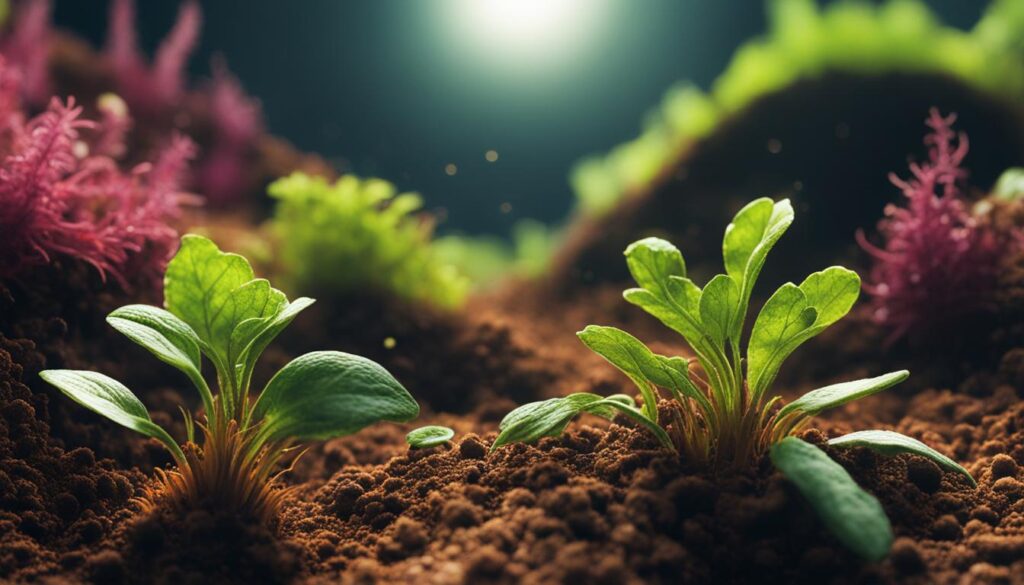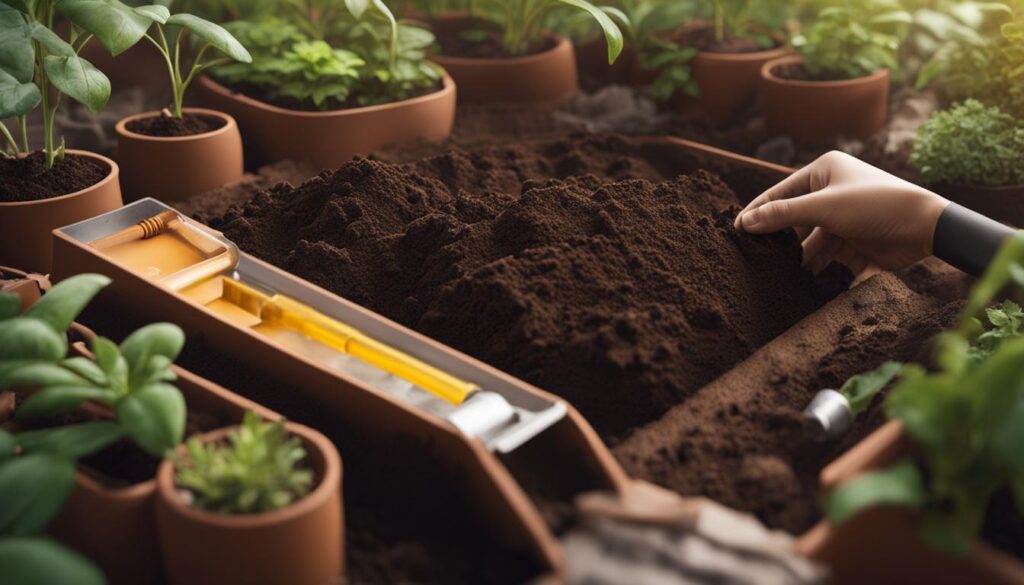Xerophilic plants require specific soil conditions to thrive in arid environments. Enhancing soil quality is crucial for promoting the growth and development of these plants. By implementing effective soil management techniques, such as improving nutrient availability and water retention, you can create an optimal environment for xerophilic plant growth. This article will explore various strategies and methods to enhance soil for xerophilic plants based on factual data from reputable sources.
Key Takeaways
- Improving nutrient availability and water retention is essential for enhancing soil quality for xerophilic plant growth.
- Understanding the impact of global climate change on soil health helps in creating more favorable soil conditions for xerophilic plants.
- Microorganisms play a vital role in enhancing soil fertility and supporting the growth of xerophilic plants.
- Choosing the right soil amendments, such as organic matter and materials that promote water infiltration, is crucial for creating a nutrient-rich and well-draining soil environment.
- Efficient irrigation practices conserve water and promote healthy root development in xerophilic plants.
Understanding the Impact of Global Climate Change on Soil Health
The first step in enhancing soil for xerophilic plant growth is to understand the impact of global climate change on soil health. Rising temperatures, erratic rainfall patterns, and increased aridity are some of the challenges posed by climate change, which directly affect soil conditions. Changes in soil temperature, moisture levels, and nutrient availability can impact plant growth and survival. By recognizing these challenges, you can adopt strategies to mitigate the effects of climate change and create more favorable soil conditions for xerophilic plants.
According to recent studies, global climate change has led to an increase in soil temperature, resulting in accelerated evaporation and decreased water retention capacity. These changes have significant implications for xerophilic plants as they rely on limited water resources in arid environments. Furthermore, increasing aridity caused by climate change can contribute to soil degradation, leading to soil erosion and loss of topsoil, which are essential for plant nutrient uptake and root development.
Another critical aspect of climate change’s impact on soil health is the alteration of nutrient availability. As temperatures rise, microbial activity in the soil can be negatively affected, impairing the natural processes that break down organic matter and release nutrients for plant uptake. This can result in nutrient deficiencies and imbalances, further compromising the growth and development of xerophilic plants.
“Climate change has the potential to reshape soil ecosystems and impact plant growth in arid regions. Understanding these changes and their consequences is crucial for implementing effective soil management techniques and ensuring the success of xerophilic plant cultivation.”
| Impact of Global Climate Change on Soil Health | Effects on Xerophilic Plant Growth |
|---|---|
| Increased soil temperature | Accelerated evaporation and decreased water retention |
| Increased aridity | Soil degradation, erosion, and loss of topsoil |
| Altered nutrient availability | Nutrient deficiencies and imbalances |
Understanding the impact of global climate change on soil health is crucial for developing effective strategies to enhance soil for xerophilic plant growth. By implementing soil management techniques that address these challenges, such as improving water retention and nutrient availability, you can create an environment that supports the resilience and vitality of xerophilic plants.
Importance of Microorganisms in Soil for Plant Nutrition
The role of microorganisms in soil is vital for supporting plant nutrition and overall plant health. Soil microorganisms form symbiotic relationships with plants, benefiting both parties involved. These beneficial microorganisms contribute to nutrient availability, disease resistance, and enhanced plant growth. By understanding the importance of these microorganisms and promoting their abundance in the soil, gardeners and farmers can create an optimal environment for xerophilic plant growth.
One example of beneficial microorganisms is plant growth-promoting rhizobacteria (PGPR). These bacteria colonize the root zone of plants and assist in nutrient uptake by solubilizing minerals and fixing atmospheric nitrogen. They also produce growth-promoting substances that stimulate root development and improve plant resilience to environmental stresses. In addition, mycorrhizal fungi form mutualistic associations with plant roots, extending their reach into the soil and facilitating the absorption of nutrients, particularly phosphorus. These fungi also enhance the plant’s ability to withstand drought and other unfavorable conditions.
The presence of these microorganisms in the soil helps create a dynamic, symbiotic relationship between plants and the surrounding environment. They improve the availability of essential nutrients, such as nitrogen, phosphorus, and potassium, by breaking down organic matter and unlocking previously inaccessible nutrients. The microorganisms also contribute to the soil’s structure, aiding in water retention and preventing erosion. Their activities promote soil aggregation, creating pore spaces that allow for proper air circulation and moisture retention, which are crucial for plant health.
The Role of Microorganisms in Soil
The beneficial microorganisms in soil play several key roles in enhancing plant nutrition:
- Enhance nutrient availability: Microorganisms break down organic matter and release nutrients in forms that are easily taken up by plants.
- Improve disease resistance: Certain microorganisms help suppress plant pathogens by competing for resources or producing antimicrobial compounds.
- Promote plant growth: Beneficial microorganisms produce growth-promoting substances that stimulate root development and enhance overall plant vigor.
- Enhance soil structure: Microorganisms contribute to the formation of soil aggregates, improving water infiltration and preventing soil erosion.
By nurturing the presence of these microorganisms in the soil, gardeners and farmers can harness their beneficial effects to enhance plant nutrition and foster the growth of xerophilic plants.
Table: Beneficial Microorganisms and Their Functions
| Microorganism | Function |
|---|---|
| Plant Growth-Promoting Rhizobacteria (PGPR) | Enhance nutrient uptake, stimulate root development, improve plant resilience |
| Mycorrhizal Fungi | Facilitate nutrient absorption, enhance drought tolerance |
| Actinomycetes | Decompose organic matter, produce antibiotics |
| Nitrogen-Fixing Bacteria | Convert atmospheric nitrogen into plant-available forms |
| Ammonifying Bacteria | Convert organic nitrogen into ammonium |
The table above highlights some of the beneficial microorganisms commonly found in soil and their respective functions. Understanding the roles they play in soil ecology can aid gardeners and farmers in implementing strategies to promote their presence and support the growth and nutrition of xerophilic plants.
By acknowledging the importance of microorganisms in soil and actively fostering their abundance, you can create a thriving soil ecosystem that enhances the nutrition, disease resistance, and overall vitality of xerophilic plants.
Selecting the Right Soil Amendments for Xerophilic Plants
Xerophilic plants require specific soil conditions to thrive in arid environments. To enhance soil quality for xerophilic plant growth, it is essential to select the right soil amendments. The use of organic matter, such as compost and manure, can greatly improve soil structure and enhance water retention capabilities. Organic matter acts as a sponge, absorbing water and slowly releasing it to the plants’ roots, ensuring optimal moisture levels for their growth.
In addition to organic matter, incorporating materials that promote water infiltration and prevent water runoff can further enhance soil water retention. Mulch, for example, helps to conserve moisture by reducing evaporation and minimizing soil temperature fluctuations. Biochar, a highly porous charcoal-like substance, can also enhance water retention while improving soil fertility by providing a habitat for beneficial microorganisms.
Table: Soil Amendments for Enhancing Water Retention
| Soil Amendment | Water Retention Benefits |
|---|---|
| Compost | Improves soil structure, enhances water-holding capacity |
| Manure | Increases water retention, enriches soil with nutrients |
| Mulch | Reduces evaporation, maintains soil moisture levels |
| Biochar | Enhances water absorption and retention, improves soil fertility |
By carefully selecting and incorporating the right soil amendments, you can create a nutrient-rich and well-draining soil environment that promotes the growth and development of xerophilic plants. Remember to consider the specific needs of your plant species and the climate conditions you are working with to determine the most suitable amendments for your soil.
Efficient Irrigation Practices for Water Conservation
Efficient irrigation practices are crucial for enhancing soil for xerophilic plant growth, while also conserving water resources. By implementing water-saving techniques and optimizing irrigation methods, you can provide adequate moisture to xerophilic plants while minimizing water wastage.
One effective irrigation method for water conservation is drip irrigation. This technique delivers water directly to the plant roots, reducing evaporation and ensuring efficient water utilization. Drip irrigation systems, such as micro-sprinklers or soaker hoses, are designed to deliver water slowly and evenly, preventing water runoff and surface evaporation.
Mulching is another practice that can help conserve water and enhance soil moisture retention. By layering organic mulch, such as wood chips or straw, around the base of plants, you can reduce soil evaporation and weed growth. Mulch acts as a protective barrier, regulating soil temperature and preventing water loss, resulting in improved water efficiency.
Key Tips for Efficient Irrigation:
- Water plants during the early morning or late evening to minimize water loss through evaporation.
- Use moisture sensors or soil moisture meters to determine when plants require irrigation, avoiding overwatering.
- Consider installing rainwater harvesting systems to collect and store rainwater for irrigation purposes.
- Group plants with similar water requirements together to ensure efficient water distribution.
By implementing these efficient irrigation practices, you can optimize water usage and create a sustainable watering routine that supports the growth of xerophilic plants.
Nutrient Management Strategies for Optimal Plant Nutrition
Nutrient management is a critical aspect of enhancing soil for xerophilic plant growth. By implementing effective strategies for soil testing and fertilization, you can ensure that your plants receive the necessary nutrients for healthy growth and development.
Soil Testing: A Key Step in Nutrient Management
One of the first steps in nutrient management is conducting regular soil testing. This process provides valuable insights into the nutrient composition of your soil, allowing you to identify deficiencies or imbalances. By understanding your soil’s specific nutrient needs, you can make informed decisions about fertilizer application and soil amendments.
Soil testing involves collecting soil samples from different areas of your planting bed and sending them to a laboratory for analysis. The lab will provide a detailed report that includes information about the levels of essential nutrients like nitrogen, phosphorus, and potassium. This data serves as a roadmap for optimizing nutrient management and ensuring the fertility of your soil.
Fertilization: A Targeted Approach to Nutrient Delivery
Once you have identified the nutrient needs of your soil through soil testing, you can apply fertilizers in a targeted manner. Fertilizers provide essential nutrients to your plants, fueling their growth and overall health.
Organic fertilizers, such as compost tea or manure, are popular choices for xerophilic plant growth. These natural sources of nutrients release their benefits slowly, providing a consistent supply of essential elements. This slow-release feature prevents nutrient leaching and minimizes the risk of over-fertilization, ensuring that your plants receive a steady and sustainable nutrient supply.
Additional Nutrient Management Strategies
In addition to soil testing and fertilization, there are other nutrient management strategies you can implement to optimize plant nutrition. These include:
- Applying micronutrient supplements to address specific nutrient deficiencies
- Using foliar feeding techniques, where nutrients are applied directly to plant leaves for rapid absorption
By adopting a comprehensive approach to nutrient management, you can provide your xerophilic plants with the ideal conditions for robust growth and development. Remember to regularly monitor your plants’ nutrient needs and adjust your nutrient management strategies accordingly for continued success.
| Nutrient | Function in Plants | Signs of Deficiency |
|---|---|---|
| Nitrogen | Essential for leaf and stem growth | Yellowing leaves, stunted growth |
| Phosphorus | Supports root development and flower formation | Purple or reddish leaves, poor flowering |
| Potassium | Aids in overall plant growth and stress tolerance | Weak stems, scorched leaf edges |
| Calcium | Strengthens cell walls and prevents diseases | Leaf tip burn, blossom end rot |
| Magnesium | Essential for chlorophyll production | Interveinal yellowing of leaves |
By addressing nutrient deficiencies or imbalances promptly and providing your plants with the nutrients they need, you can ensure optimal plant nutrition and achieve thriving xerophilic plant growth.
“Proper nutrient management is the foundation for healthy and productive xerophilic plants. By conducting soil testing and implementing targeted fertilization strategies, you can provide your plants with the essential nutrients they need to thrive.”
Soil pH and Its Impact on Plant Health
The pH level of soil plays a crucial role in the health and growth of xerophilic plants. Different plants have specific pH preferences, and maintaining the right soil pH is essential for nutrient availability and optimal plant health. Soil pH is a measure of the acidity or alkalinity of the soil, ranging from 0 to 14, with 7 being neutral. pH values below 7 indicate acidic soil, while values above 7 indicate alkaline soil.
Acidic soil (pH below 7) can hinder nutrient uptake and affect plant health. It can lead to deficiencies in essential nutrients like calcium, magnesium, and phosphorus. In acidic soil, aluminum and manganese may become more soluble, potentially causing toxicity to plants. To raise the pH of acidic soil, gardeners and farmers can add lime or other alkaline materials to neutralize the acidity and create a more favorable growing environment for xerophilic plants.
On the other hand, alkaline soil (pH above 7) can also impact plant health. In alkaline soil, certain essential nutrients, such as iron, manganese, and zinc, may become less available to plants. This can result in nutrient deficiencies and affect overall plant growth. To lower the pH of alkaline soil, gardeners and farmers can add sulfur or other acidifying agents to create a more balanced pH level. Maintaining the appropriate soil pH for xerophilic plants promotes proper nutrient uptake and encourages healthy plant development.
Effects of Soil pH on Nutrient Availability
The pH level of the soil directly impacts the availability of nutrients to plants. Certain nutrients become more or less available at different pH levels. Below is a table illustrating the effects of soil pH on nutrient availability:
| Nutrient | Availability at acidic soil (pH < 7) | Availability at neutral soil (pH = 7) | Availability at alkaline soil (pH > 7) |
|---|---|---|---|
| Nitrogen (N) | Low | Optimal | Low |
| Phosphorus (P) | High | Optimal | Low |
| Potassium (K) | High | Optimal | Low |
| Iron (Fe) | High | Optimal | Low |
| Zinc (Zn) | High | Optimal | Low |
As shown in the table, acidic soil tends to have higher availability of nutrients like nitrogen, phosphorus, potassium, iron, and zinc. On the other hand, alkaline soil may have lower availability of these nutrients. It is important to adjust the soil pH to ensure the optimal availability of nutrients for xerophilic plants.
“Maintaining the appropriate soil pH for xerophilic plants is crucial for nutrient uptake and overall plant health. Understanding the effects of soil pH on nutrient availability can help gardeners and farmers make informed decisions when adjusting pH levels.”
Managing Soil Salinity for Xerophilic Plants
Soil salinity can present challenges for the successful growth of xerophilic plants. Excessive salt levels in the soil can hinder nutrient uptake and cause water stress, impacting the overall health and vitality of these plants. However, by implementing effective irrigation management practices and incorporating salt-tolerant plants into your garden or farming system, you can manage soil salinity and create an environment conducive to the growth of xerophilic plants.
Irrigation management is key to mitigating soil salinity issues. Proper watering techniques can help leach excess salts from the soil, preventing their accumulation and adverse effects on plant health. Deep watering or employing drip irrigation systems can facilitate the percolation of water through the soil, flushing out any accumulated salts. By ensuring adequate drainage during irrigation, you can promote the removal of excess salts, maintaining a healthier soil environment for xerophilic plants.
Another approach to managing soil salinity is the use of salt-tolerant plants. These plants have natural mechanisms to tolerate higher salt levels, making them well-suited for growth in saline soils. By incorporating salt-tolerant species into your planting beds, you can enhance the overall resilience of your garden or farm. These plants can withstand the challenging conditions associated with soil salinity and continue to thrive, providing beauty and productivity to your landscape.
| Salt-Tolerant Plant Varieties | Description |
|---|---|
| Salicornia europaea | A succulent plant commonly known as samphire or glasswort, with high salt tolerance. It is often used in culinary applications. |
| Atriplex halimus | Also known as saltbush, this shrub is highly resistant to saline soils and can be used as forage for livestock. |
| Sporobolus virginicus | This grass species, commonly called seashore dropseed, can tolerate a wide range of soil salinity levels and is often used for erosion control. |
By combining effective irrigation management practices and the use of salt-tolerant plants, you can successfully manage soil salinity and create an environment that supports the growth of xerophilic plants. Implementing these strategies will not only enhance the health and productivity of your garden or farm but also contribute to the overall sustainability of your landscaping efforts.
Enhancing Soil Drainage for Xerophilic Plants
When it comes to enhancing soil for xerophilic plant growth, one crucial factor to consider is soil drainage. Xerophilic plants thrive in well-draining soils, as waterlogged conditions can lead to root rot and other health issues. Poor drainage can impede the uptake of nutrients and oxygen, ultimately hindering the growth and development of these plants. To create an optimal growing environment, implementing strategies to enhance soil drainage is essential.
One effective method to improve soil drainage is through raised bed gardening. Raised beds are elevated planting areas that allow excess water to drain away more efficiently, preventing waterlogging. These beds are constructed using a border or frame, filled with a mixture of quality soil and organic matter. Raised beds not only enhance drainage but also provide better control over soil quality, temperature, and weed growth. This method is particularly beneficial for gardens with heavy clay soils or areas prone to water accumulation.
In addition to raised bed gardening, amending the soil with organic matter can also help improve soil drainage. Organic matter, such as compost or well-rotted manure, improves soil structure, allowing for better water infiltration and drainage. It also helps break up compacted soils, creating channels for excess water to escape. By incorporating organic matter into the soil, gardeners can create a more favorable environment for xerophilic plants.
Table: Benefits of Raised Bed Gardening for Enhancing Soil Drainage
| Benefits | Description |
|---|---|
| Improved Drainage | Raised beds provide better drainage, preventing waterlogging and root rot. |
| Control over Soil Quality | Gardeners have greater control over the soil composition, ensuring optimal conditions for plant growth. |
| Temperature Regulation | Raised beds warm up faster in spring and maintain higher soil temperatures, promoting plant growth. |
| Weed Suppression | Raised beds help to suppress weed growth, reducing competition for nutrients and resources. |
In conclusion, enhancing soil drainage is essential for creating an optimal environment for xerophilic plants. Raised bed gardening and incorporating organic matter into the soil are effective strategies to improve drainage and prevent waterlogged conditions. By implementing these techniques, gardeners can ensure that xerophilic plants receive the proper aeration, water infiltration, and drainage they need to thrive.
Sustainable Pest and Disease Management in Xerophilic Planting Beds
Sustainable pest and disease management practices are crucial for maintaining healthy xerophilic planting beds. By adopting integrated pest management (IPM) strategies and utilizing natural remedies, you can effectively minimize pest and disease pressure without compromising the health of your plants or the environment.
Integrating IPM Strategies: Implementing IPM strategies involves a multi-faceted approach to pest and disease management. Crop rotation is a beneficial practice that helps disrupt pest life cycles and reduces the risk of reinfestation. Additionally, introducing beneficial insects or using biological control methods, such as nematodes or predatory mites, can help control pests naturally.
“IPM combines biological, cultural, physical, and chemical controls to manage pests efficiently and sustainably. It aims to minimize pesticide use and prioritize methods that are environmentally friendly and economically viable.” – Dr. Jane Green, Entomologist
Utilizing Natural Remedies: Natural remedies can be effective alternatives to synthetic pesticides when managing pests and diseases in xerophilic planting beds. Neem oil, derived from the neem tree, acts as a natural insecticide and fungicide. Garlic spray, made from crushed garlic cloves and water, can deter pests while promoting plant health. These remedies provide environmentally friendly options and minimize the harmful effects on beneficial insects.
Pest and Disease Management Techniques
Here are some pest and disease management techniques to consider:
- Sanitation: Regularly remove plant debris and weeds from your planting beds to eliminate hiding places for pests and reduce disease pressure.
- Monitoring: Keep a close eye on your plants for any signs of pests or diseases. Early detection allows for timely interventions and better control.
- Companion Planting: Planting certain flowers, herbs, or vegetables together can help repel pests or attract beneficial insects, creating a natural ecological balance.
- Physical Barriers: Use row covers, netting, or fences to physically block pests from accessing your plants. This can be particularly effective against insects and larger animals.
- Organic Sprays: Homemade sprays using ingredients like soap, oil, or chili pepper can deter pests without harming your plants or the environment.
By incorporating sustainable pest and disease management practices into your xerophilic planting beds, you can ensure the health and vitality of your plants while minimizing the negative impacts on the environment.
How Can I Use Xerophytes to Enhance Soil for Xerophilic Plant Growth?
Xerophytes are perfect for waterefficient garden planning with xerophytes. These plants have adapted to survive in dry environments and can enhance soil by improving water retention and nutrient availability. By incorporating xerophytes into the garden, soil health can be improved to support the growth of xerophilic plants.
Conclusion
In conclusion, to enhance soil for xerophilic plant growth, it is essential to implement effective soil management techniques. By improving nutrient availability, water retention, and drainage, you can create an ideal environment for these plants to thrive and flourish. Understanding the impact of global climate change on soil health is crucial, as it directly affects the conditions in which xerophilic plants grow.
The presence of microorganisms in the soil plays a vital role in enhancing plant nutrition. By promoting the abundance of beneficial microorganisms through practices such as crop rotation and the use of organic fertilizers, you can enhance soil fertility and support the growth of xerophilic plants.
Selecting the right soil amendments, implementing efficient irrigation practices, and adopting effective nutrient management strategies are key factors in providing optimal conditions for xerophilic plants. Additionally, managing soil pH, salinity, and drainage, along with implementing sustainable pest and disease management practices, completes the comprehensive approach to enhancing soil for xerophilic plant growth.
By following these soil management techniques, you can create a nutrient-rich and well-draining soil environment that fosters the growth and development of xerophilic plants. So, get ready to unlock the secrets of enhancing soil for xerophilic plant growth and witness the thriving beauty of these unique plants in your garden or farm!














